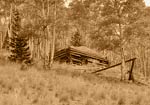

Oro Fino
Denmark
Deldosso
Silver Queen
Enderman



![]()
![]()
![]()
In the late 1890s, John Lachaniche and Louis Marchino began prospecting the upper Bitter Creek Canyon about five miles above Red River City. For quite some time their work went unrewarded, but the two men were persistent and they staked several claims. Finally, in 1904 a rich strike was made at the Independence Claim which assayed about $7,000 a ton. This created great excitement throughout the area and a flurry of prospecting up and down Bitter Creek Canyon. Several miners staked claims near the Independence and a road was begun down the canyon toward Red River City.
At the new mine a great deal of preparation took place. A shaft house was built, a hoist and compressor were put in place and several buildings were constructed, including a mill, assay office, and bunkhouse. As mining got underway, the enthusiasm was suddenly dampened by a rather strange occurrence. The U. S. Freehold and Emigration Company, which owned the Costilla Estate of the Sangre de Cristo Land Claim, claimed that the Independence Mine was actually on their property and therefore subject to certain fees and rents. Immediately, work at the Independence was stopped and a U. S. surveyor from Denver was hired to settle the question. After extensive work he declared that the Independence was located more than a mile west of the Freehold Company land. However, the Company refused to accept the report and opened a lawsuit.
During all of the months of wrangling and confusion, efforts were made to keep the mine operating, but the owners financial resources were gradually stretched and then finally exhausted. They were subsequently forced to sell a controlling interest in the mine to Dr. William Powell of Philadelphia. With this infusion of new capital and an apparent settling of the legal difficulties, work at the mine once again began in earnest. During 1906, superintendent J. A. Zwergel employed a total of 24 miners and was able to install a new air compressor and several new air drills. Over the next months the ore proved to be rather variable and though a number of tons were shipped to the Moreno Valley, the overall return was only fair. By the following year, the rich pocket played out completely and there was another threat of a lawsuit. Because of this, the owners elected to stop work completely.
After 1910 there was renewed interest in all of the Red River mines, brought about by some new gold discoveries, an influx of new people, improved economic conditions in general and improved mining equipment and techniques. The Independence was put back in operation, but over the next few years it barely made expenses. In 1917 John Lachamiche was killed in a mine explosion and his estate was placed in the hands of an administrator. The mine was temporarily leased to C. C. Lowe who cleared and reworked it. He was able to find one small vein which produced several feet of ore assayed ten to twenty dollars a ton. Lowe was encouraged to begin mine operations, but he suddenly lost his lease. The court administrator turned the property over to an heir of Lachaniche and this man had no interest in the mine. Thus, the Independence Mine was finally closed.

Independence Mine

Independence Cabin

Independence Cabin

Mine Entrance

Mine Tailings

Mine Shaft

